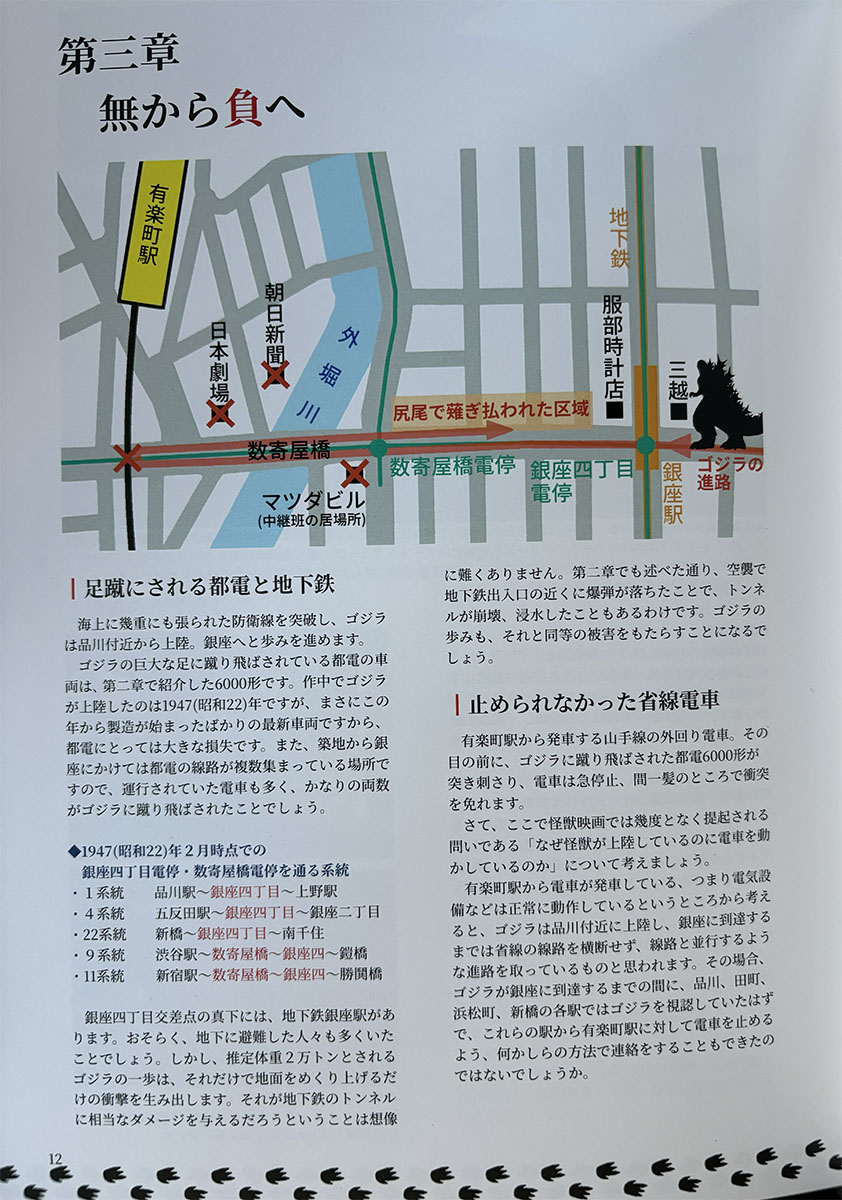2.8.2024
Minus One attack Ginza map

第三章
Chapter 3
無から負へ
From nothing to negative
Map
有楽町駅 Yurakucho Station
地下鉄 subway
朝日新聞 Asahi Shimbun
服部時計店 Hattori watch store
外堀川 Sotobori River
日本劇場 Nichogeki
三越 Mitsukoshi
尻尾で薙ぎ払われた区域 Area mowed down by the tail
数寄屋橋 Sukiyabashi
数寄屋橋電停 Sukiyabashi tram stop
銀座四丁目電停 Ginza 4-chome tram stop
ゴジラの進路 Godzilla’s path
銀座駅 Ginza station
マツダビル(中継班の居場所) Mazda Building (relay team location)
「足蹴にされる都電と地下鉄
Toden and subway trains being kicked
海上に幾重にも張られた防衛線を突破し、ゴジラは品川付近から上陸。銀座へと歩みを進めます。
Breaking through the many layers of defense lines on the sea, Godzilla landed near Shinagawa. He proceed to Ginza.
ゴジラの巨大な足に蹴り飛ばされている都電の車両は、第二章で紹介した6000形です。作中でゴジラが上陸したのは1947(昭和22)年ですが、まさにこの年から製造が始まったばかりの最新車両ですから、都電にとっては大きな損失です。また、築地から銀座にかけては都電の線路が複数集まっている場所ですので、運行されていた電車も多く、かなりの両数がゴジラに蹴り飛ばされたことでしょう。
The Toden train that is being kicked away by Godzilla’s giant legs is the 6000-type train that was introduced in Chapter 2. In the story, Godzilla landed in 1947 (Showa 22), but this was a huge loss for Toden, as it was the latest train that had just started production in that year. Also, since Tsukiji to Ginza is an area where multiple Toden lines converge, there were many trains in operation, and many of them must have been kicked away by Godzilla.
◆ 1947(昭和22)年2月時点での
銀座四丁目電停・数寄屋橋電停を通る系統
· 1系統 品川駅~銀座四丁目~上野駅
· 4系統 五反田駅~銀座四丁目~銀座二丁目
· 22系統 新橋~銀座四丁目~南千住
· 9系統 渋谷駅~数寄屋橋~銀座四~鐵橋
· 11系統 新宿駅~数寄屋橋~銀座四~勝鬨橋
◆ As of February 1947 (Showa 22)
System passing through Ginza 4-chome tram stop and Sukiyabashi tram stop
· Line 1 Shinagawa Station ~ Ginza 4-chome ~ Ueno Station
· Line 4 Gotanda Station ~ Ginza 4-chome ~ Ginza 2-chome
· Route 22 Shinbashi ~ Ginza 4-chome ~ Minamisenju
· Line 9 Shibuya Station ~ Sukiyabashi ~ Ginza 4 ~ Tetsubashi
· Line 11 Shinjuku Station ~ Sukiyabashi ~ Ginza 4 ~ Kachidoki Bridge
銀座四丁目交差点の真下には、地下鉄銀座駅があります。おそらく、地下に避難した人々も多くいたことでしょう。しかし、推定体重2万トンとされるゴジラの一歩は、それだけで地面をめくり上げるだけの衝撃を生み出します。それが地下鉄のトンネルに相当なダメージを与えるだろうということは想像に難くありません。第二章でも述べた通り、空襲で地下鉄出入口の近くに爆弾が落ちたことで、トンネルが崩壊、浸水したこともあるわけです。ゴジラの歩みも、それと同等の被害をもたらすことになるで「しょう。
Ginza Subway Station is directly below the Ginza 4-chome intersection. There were probably many people who took shelter underground. However, each step of Godzilla, who weighs an estimated 20,000 tons, creates enough impact to turn over the ground. It’s not hard to imagine that it would cause considerable damage to the subway tunnels. As mentioned in Chapter 2, bombs dropped near subway entrances during air raids caused tunnels to collapse and flood. Godzilla’s steps would cause the same amount of damage.
「止められなかった省線電車
Ministry line train that could not be stopped
有楽町駅から発車する山手線の外回り電車。その目の前に、ゴジラに蹴り飛ばされた都電6000形が突き刺さり、電車は急停止、間一髪のところで衝突を免れます。
Yamanote Line outer train departing from Yurakucho Station. In front of them, a Toden 6000, which was kicked by Godzilla, crashes into them, and the train comes to a sudden stop, narrowly escaping a collision.
さて、ここで怪獣映画では幾度となく提起される問いである「なぜ怪獣が上陸しているのに電車を動かしているのか」について考えましょう。
Now, let’s consider a question that is often raised in monster movies: “Why are the trains moving even though the monsters have landed?”
有楽町駅から電車が発車している、つまり電気設備などは正常に動作しているというところから考えると、ゴジラは品川付近に上陸し、銀座に到達するまでは省線の線路を横断せず、線路と並行するような進路を取っているものと思われます。その場合、ゴジラが銀座に到達するまでの間に、品川、田町、浜松町、新橋の各駅ではゴジラを視認していたはずで、これらの駅から有楽町駅に対して電車を止めるよう、何かしらの方法で連絡をすることもできたのではないでしょうか。
Considering that the train is departing from Yurakucho Station, which means that the electrical equipment is operating normally, Godzilla landed near Shinagawa and did not cross the provincial line until it reached Ginza. It seems that it is taking a course parallel to the railroad tracks. In that case, by the time Godzilla reached Ginza, Godzilla would have been visible at Shinagawa, Tamachi, Hamamatsucho, and Shinbashi stations, and something would have been done to stop trains from these stations to Yurakucho station. There may be other ways to contact them.
Source: しらゆき創作工房 街と電車と其の怪物 稲本海 ゴジラ-1.0, The City, the Train, and the Monster (Kai Inamoto) Godzilla-1.0